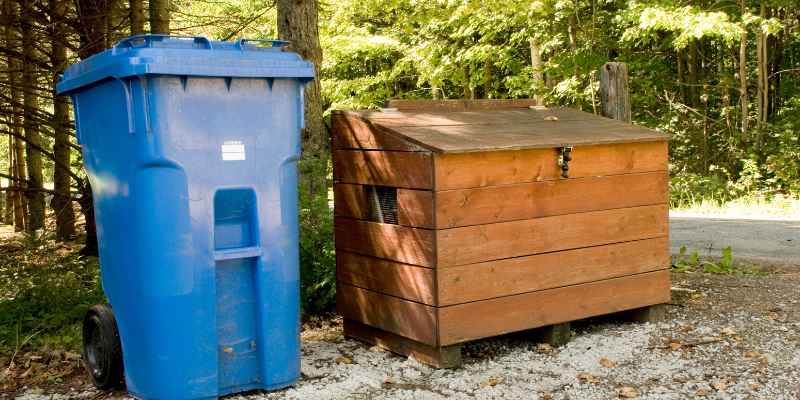Wood can be recycled, as it can be reused as a building material, mulch for landscaping, or produced into paper pulp. Recycling wood helps reduce the need to cut down trees and lessens the environmental impact.
Additionally, wood waste can be disposed of at specialized wood recycling facilities or through land clearing services. However, it’s not typically accepted in curbside recycling programs due to the complex process required to convert it into paper. Therefore, it’s important to explore alternative disposal methods such as utilizing dedicated wood recycling centers, composting, or seeking out organizations that accept wood waste.
By actively seeking out specific wood waste disposal options, individuals can contribute to sustainable waste management practices and environmental conservation efforts.
The Debate: Wood As Garbage Or Recycling
Wood waste can be both garbage and recycling. While it is not recommended to dispose of wood waste in the general waste bin, it can be reused as building material, mulch, or even as fuel. Recycling wood helps reduce the need to cut down trees and supports a more sustainable approach to waste management.
Wood waste poses a significant environmental concern, sparking an ongoing debate about whether it should be classified as garbage or considered for recycling. Understanding this controversy is crucial, as it impacts waste management practices and influences how we dispose of wood materials. Let’s delve into the contentious issues surrounding wood waste and explore the various perspectives on its disposal.
The Controversy Surrounding Wood Waste
Wood, being a versatile and renewable resource, has been heavily utilized in construction, furniture making, and various other industries. However, its disposal has become a subject of controversy due to the environmental implications. Some argue that wood waste belongs in the same category as general garbage, while others advocate for its recycling.
Recycling wood waste can have numerous benefits, including reducing the amount of waste sent to landfills and minimizing the need for virgin wood from forests. Additionally, recycling wood can contribute to the production of new building materials, mulch for landscaping, paper pulp, and even renewable energy sources.
However, critics of wood recycling argue that the process is complex and not always cost-effective. Converting wood into reusable products often requires removing bark, shredding, pulping, treating with chemicals, and additional processing steps. Some municipalities are not equipped to handle these procedures, which leads to limited recycling options for wood waste.
Waste Management Practices And Wood Disposal
When it comes to waste management practices, disposing of wood waste can differ depending on local regulations and available facilities. In some cases, wood waste can be placed in general waste bins, but this is typically not recommended due to the potential for recycling and reusing this valuable resource.
In the United Kingdom, for example, various recycling centers and organizations accept wood waste for reuse, recycling, or proper disposal. These facilities ensure that wood is diverted from landfills and instead repurposed for different purposes, such as manufacturing new products, producing renewable energy, or enriching soil through mulching.
Furthermore, in Austin, Texas, residents and businesses can make use of dedicated wood recycling facilities like Austin Wood Recycling North. These specialized centers offer services such as land clearing, grinding, hauling, and the production of landscaping products. By utilizing these resources, the local community promotes sustainable waste management practices while supporting the reuse and recycling of wood waste.
In conclusion, the debate surrounding wood as garbage or recycling remains ongoing. While some argue for the convenience of placing wood waste in general bins, others emphasize the environmental and economic benefits of recycling. Ultimately, responsible waste management practices and access to appropriate recycling facilities play a crucial role in determining the fate of wood waste materials.
Wood Waste In General Waste Bins
Wood waste should not go into general waste bins. While it can be disposed of there, it is better recycled. Wood waste can be reused for building materials, mulch, paper production, and even as fuel, reducing the need for cutting down trees.
Acceptance Of Wood Waste In General Waste Bins
Wood waste, such as old furniture, timber scraps, or broken wooden items, can be disposed of in general waste bins. Although it is accepted in these bins, it is not considered a recommended practice. Putting wood waste in general waste bins means it will end up in a landfill, where it takes a considerable amount of time to decompose and contributes to environmental pollution. However, in some cases, homeowners or businesses may have no other option but to dispose of wood waste in general waste bins.
Recommended Practices For Disposing Wood Waste
If you want to dispose of wood waste in a more sustainable and eco-friendly way, there are several recommended practices you can follow:
- Recycling: Most wood waste can be recycled and reused as a building material, mulch for landscaping, or pulp for paper production. Recycling wood not only helps conserve natural resources but also reduces the need to cut down more trees.
- Wood Recycling Facilities: Look for local wood recycling facilities or centers where you can drop off your wood waste. These facilities have specialized equipment to process and recycle wood waste effectively.
- Donate or Repurpose: If the wood is still in good condition, consider donating it to organizations or individuals who may need it for repurposing. Old furniture, for example, can be refurbished or upcycled instead of being thrown away.
- Composting: Certain types of wood waste, such as untreated sawdust or wood chips, can be used for composting. These materials can provide carbon-rich organic matter to enhance soil fertility.
By adopting these recommended practices, you can ensure that wood waste is given a second life instead of ending up in landfills. Remember to always check with local regulations and facilities to ensure proper disposal methods are followed.
Recycling Wood Waste
Recycling wood waste is a sustainable and environmentally friendly solution that offers numerous benefits. Instead of considering wood as garbage, we can repurpose and recycle it, contributing to waste reduction and conserving natural resources.
Reuse And Recycling Opportunities For Wood Waste
Wood waste can be reused and recycled in various ways, serving different purposes. Here are some opportunities for reusing and recycling wood waste:
- Construction and Building Materials: Wood waste can be reclaimed and used as construction and building materials. Repurposing wood waste for various construction projects not only helps reduce the need for new materials but also saves costs.
- Mulch for Landscaping: Wood waste can be chipped and converted into mulch, which is commonly used for landscaping purposes. Mulch helps retain moisture, suppresses weed growth, and adds aesthetic appeal to gardens and flowerbeds.
- Paper Production: Certain types of wood waste can be recycled into pulp and used for paper production. Recycling wood waste for paper production reduces the demand for virgin wood fibers, thereby protecting forests and supporting sustainable paper manufacturing.
- Biomass and Energy Generation: Wood waste can be processed into chips or pellets and utilized as a renewable source of energy. Biomass generated from wood waste can be used for heat and electricity production, reducing reliance on fossil fuels.
Economic And Environmental Benefits Of Wood Recycling
Wood recycling offers both economic and environmental advantages. By diverting wood waste from landfills and integrating it into the recycling loop, we can harness the following benefits:
- Waste Reduction: Recycling wood waste helps reduce landfill space usage and mitigates the negative environmental impacts associated with landfilling.
- Resource Conservation: Reusing and recycling wood waste reduces the need for harvesting new trees. This conserves forests, preserves biodiversity, and promotes sustainable land management.
- Cost Savings: Incorporating recycled wood into construction projects and other applications can lead to cost savings compared to using new materials.
- Energy Efficiency: Utilizing wood waste as a biomass fuel source contributes to renewable energy production, reducing greenhouse gas emissions and dependence on non-renewable energy sources.
Considering the numerous opportunities for reusing and recycling wood waste, it is evident that wood should not be considered as garbage, but rather as a valuable resource that can be utilized sustainably. By embracing wood recycling, we can contribute to a greener and more sustainable future.
Challenges Of Wood Recycling

Complexity Of Wood Recycling Process
Wood recycling involves a complex process due to the various types of wood and treatments they undergo.
Municipalities’ Policies On Wood Recycling
Municipalities have different policies regarding wood recycling, creating inconsistencies in recycling practices.
Wood Disposal And Recycling Facilities
Wood disposal and recycling facilities play a crucial role in managing and repurposing wood waste. When it comes to disposing of wood waste, it is important to explore sustainable options to reduce environmental impact while promoting resource efficiency. Apart from standard waste disposal methods, wood recycling facilities offer viable solutions to handle wood waste, contributing to a circular economy and sustainable resource management.
Available Options For Wood Disposal In Austin
In Austin, Texas, individuals and businesses have access to various options for wood disposal. From curbside collection services to drop-off locations, the city provides convenient solutions to manage wood waste. Residents can make use of the curbside collection services offered by Austin Resource Recovery, allowing for the proper disposal of wood items in designated waste bins for efficient collection and disposal.
- Curbside collection services for wood waste
- Drop-off locations for wood disposal
Services Offered By Wood Recycling Facilities
Wood recycling facilities in Austin offer comprehensive services for handling wood waste in an environmentally friendly manner. These facilities provide efficient wood grinding, land clearing, and landscaping products, catering to both commercial and residential needs. Additionally, wood recycling facilities contribute to reducing landfill waste and promoting the reuse of wood materials through mulching and other sustainable practices.
| Facility Services | Description |
|---|---|
| Wood grinding | Efficient processing of wood waste |
| Landscaping products | Offering sustainable wood-based products |
| Market | Catering to commercial and residential clients |
Guidelines For Wood Disposal
When it comes to disposing of wood, it’s essential to follow the proper guidelines to ensure environmental sustainability and safety. Whether it’s for residential or commercial purposes, knowing the right methods for wood disposal can make a significant impact on reducing waste and promoting recycling.
Prohibited Wood Items In Recycling Bins
Proper disposal of wood is crucial to ensure that it doesn’t end up in landfills, contributing to environmental degradation. However, when it comes to recycling bins, certain wood items are prohibited due to their potential impact on recycling processes. Items such as pressure-treated wood, painted wood, and treated lumber are not suitable for regular recycling bins.
Alternative Solutions For Pressure Treated Wood
When it comes to pressure-treated wood, it’s essential to seek alternative solutions for disposal. This type of wood contains chemicals that make it unsuitable for traditional recycling processes. Instead, consider seeking specialized facilities that handle hazardous wood waste disposal to ensure it is managed in an environmentally-friendly manner.
Is Wood Recyclable?
Wood is recyclable and can be reused as a building material, recycled into mulch, paper production, or as a fuel source. It’s not recommended to dispose of wood waste in the general waste bin, as recycling wood reduces the need to cut down trees and helps in sustainable resource management.
Wood’s Recyclability In Curbside Programs
Wood is a recyclable material that can be repurposed instead of ending up in landfills. When it comes to curbside recycling programs, wood items are usually not accepted due to their size and composition.
Implications Of Putting Wood In Recycling Bins
Putting wood in recycling bins can lead to contamination of other recyclable materials. It can also cause damage to recycling equipment, leading to inefficiencies in the recycling process.

Frequently Asked Questions Of Is Wood Garbage Or Recycling
Can You Put Wood In General Waste Bin?
Yes, you can put wood waste in your general waste bin, but it’s not recommended. Wood can be recycled and reused as building material, mulch, or fuel, reducing the need to cut down trees. Check the local guidelines for proper wood disposal.
Can You Recycle Wood Waste?
Yes, wood waste can be recycled. It can be reused as a building material, turned into mulch, or used for paper production and fuel. Recycling wood reduces the need to cut down trees and promotes sustainability. Many wood recycling facilities accept and process wood waste for reuse.
Where Can I Dispose Of Wood In Austin?
You can dispose of wood in Austin at Austin Wood Recycling North, where they offer land clearing, grinding, hauling, tractor mowing, and landscaping products. It is not recommended to put wood in your general waste bin, but it can be recycled as a building material, mulch, or fuel.
Recycling wood reduces the need to cut down trees.
Why Is Wood Not Recycled?
Wood is not recycled as it requires a complex process to convert it into paper or other materials. Municipalities often do not accept wood in recycling bins as it needs to be debarked, shredded, pulped, and treated with chemicals and heat to remove lignin and bleach it.
Reusing and recycling wood is beneficial as it reduces the need for tree cutting.
Conclusion
Opting to recycle wood is more beneficial than treating it as garbage. Recycling wood promotes sustainability by reducing the need for tree cutting and finding various valuable reuse options. Make the eco-conscious choice to recycle wood for a greener future.


